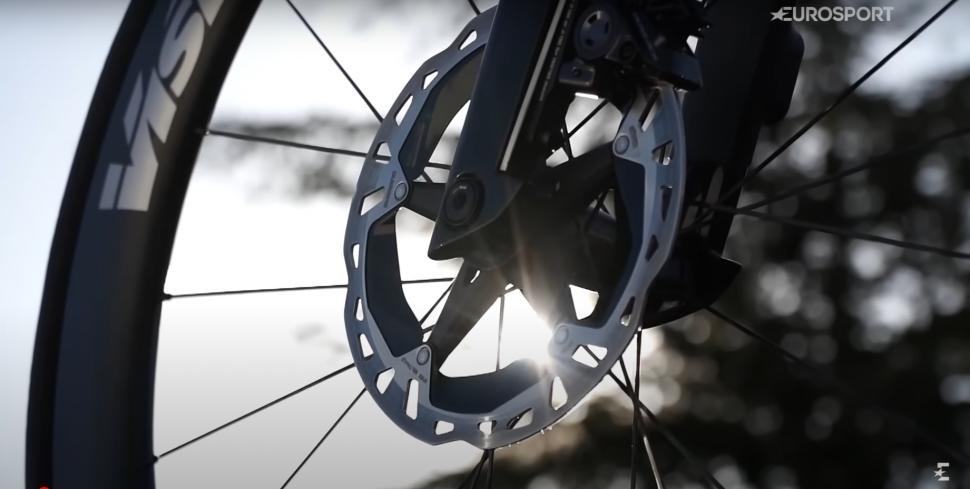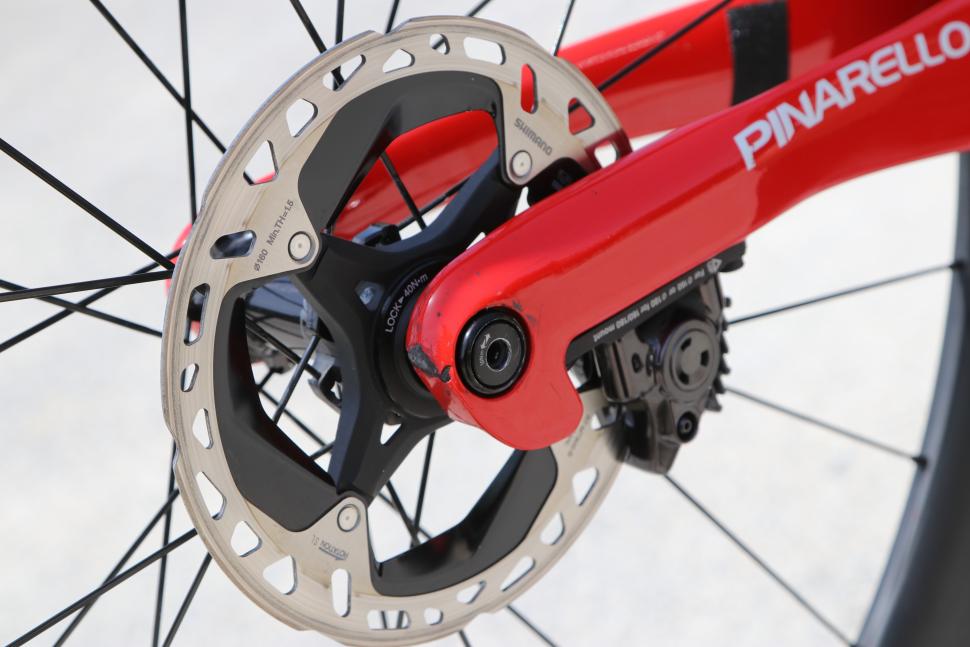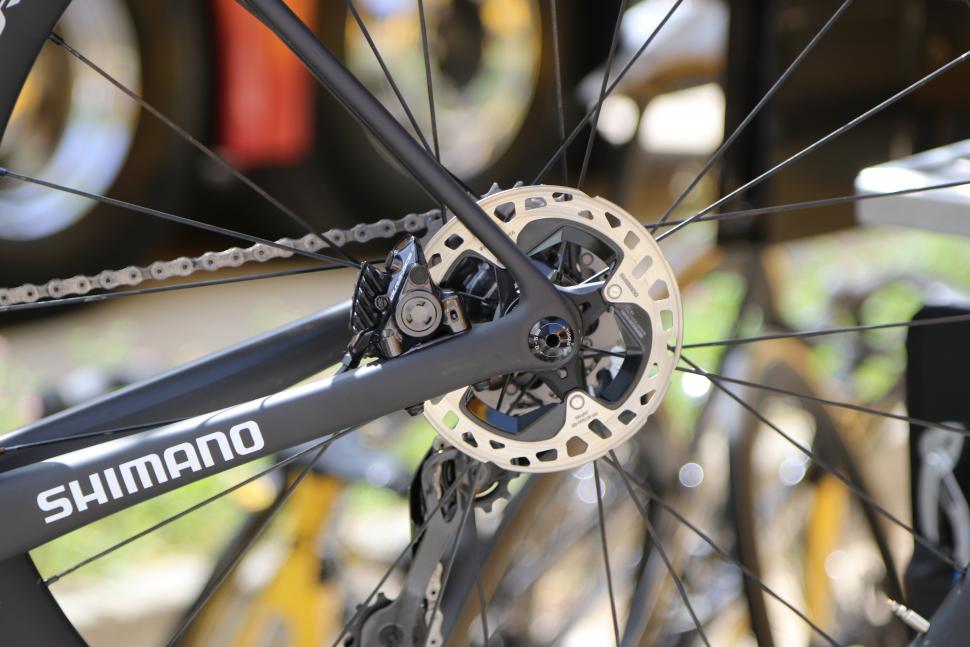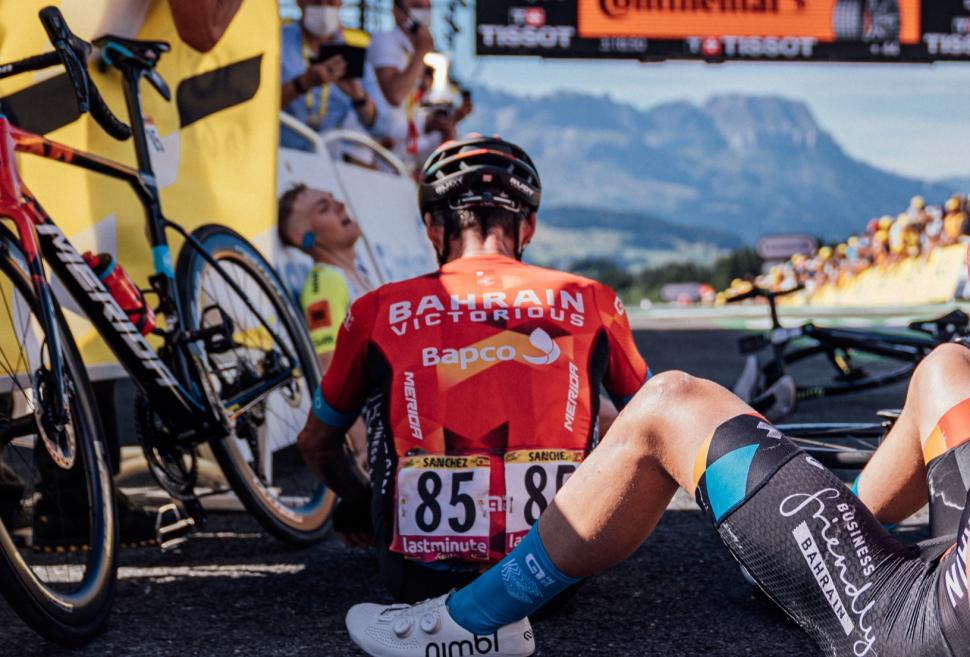- News
- Reviews
- Bikes
- Accessories
- Accessories - misc
- Computer mounts
- Bags
- Bar ends
- Bike bags & cases
- Bottle cages
- Bottles
- Cameras
- Car racks
- Child seats
- Computers
- Glasses
- GPS units
- Helmets
- Lights - front
- Lights - rear
- Lights - sets
- Locks
- Mirrors
- Mudguards
- Racks
- Pumps & CO2 inflators
- Puncture kits
- Reflectives
- Smart watches
- Stands and racks
- Trailers
- Clothing
- Components
- Bar tape & grips
- Bottom brackets
- Brake & gear cables
- Brake & STI levers
- Brake pads & spares
- Brakes
- Cassettes & freewheels
- Chains
- Chainsets & chainrings
- Derailleurs - front
- Derailleurs - rear
- Forks
- Gear levers & shifters
- Groupsets
- Handlebars & extensions
- Headsets
- Hubs
- Inner tubes
- Pedals
- Quick releases & skewers
- Saddles
- Seatposts
- Stems
- Wheels
- Tyres
- Health, fitness and nutrition
- Tools and workshop
- Miscellaneous
- Cross country mountain bikes
- Tubeless valves
- Buyers Guides
- Features
- Forum
- Recommends
- Podcast
TECH NEWS
 2022 TdF TBV Vision Shimano 180mm disc rotor
2022 TdF TBV Vision Shimano 180mm disc rotorIs bigger better? 180mm disc brake rotor spotted on Tour de France bike
As we hit the third rest day, Team Bahrain Victorious has so far found a stage win at this year's Tour de France elusive, but could it have found a solution in the use of a huge 180mm front disc rotor.
Fred Wright has come closest to a stage victory, finishing second on Stage 13, but many Bahrain Victorious riders have only been noticeable by their absence. Even Matej Mohoric doesn't appear to be his usual self and it's been down to Tom Pidcock of Ineos Grenadiers to impress on the descents.
But Bahrain Victorious has a new weapon in its armoury. We spotted one of their bikes just before the start of Stage 14 fitted with a huge 180mm front disc rotor.
Typically in the pro peloton, we see riders and teams opting for a 160mm disc at the front and a 140mm disc at the rear. This is often what bikes get sold with as standard and seems to strike a good balance between braking power, heat dissipation and weight.
We do sometimes see smaller riders using a 140mm disc at both the front and the rear as their lower mass means they don't need as much braking power and are less likely to overheat a rotor even on the Tour's long descents.
> How fast!? We analyse Tom Pidcock's stage-winning Strava file
Many teams like all their riders to be using a consistent brake rotor size as it makes wheel swaps much simpler – any rider can have any wheel off the roof of the team car. Using 160mm and 140mm rotors also makes it more likely that the neutral service will be able to help the rider in an emergency. This year neutral service is provided by Shimano which has taken over from Mavic.
> Did disc brakes get Pogacar dropped?
Shimano also supplies Team Bahrain Victorious, using the Dura-Ace R9200 12-speed groupset at this year's Tour. The groupset uses M900 Ice-Tech Freeze rotors borrowed from the brand's XTR top-of-the-range mountain bike (MTB) groupset.
Being designed for mountain bikes, there are some huge sizes available but Shimano only sells 140 or 160mm for road use. Both of those options feature four arms connecting the braking surface to the centre lock whereas the one pictured on the Bahrain Victorious bike clearly uses five as found on the 180mm+ rotors.
> Review: Shimano Dura-Ace R9200 groupset
The move to the MTB rotors comes after complaints of the older style Dura-Ace discs warping when hot and then rubbing on the pads. In my experience, it is a definite improvement and when combined with the additional 10% pad clearance of the latest callipers, it does almost eliminate the problem with a good set-up.
> Chris Froome STILL has disc brake problems
So why would anyone use a bigger rotor? Well, we've been asking ourselves the same question as this change to 180/160mm rotors is likely costing the rider 60-70g when compared to a 160/140mm setup.
We do often see huge rotors used on mountain bikes because they provide greater leverage and torque to stop the rotation due to the fact that they are further away from the rotating axle (the hub). In plain English, that means more braking power but as the limiting factor in road riding is usually the tyre's contact with the road, is that not a bit unnecessary?
Well, we think yes but the unknown Bahrain Victorious rider was clearly quite set on the idea as the bike requires a different calliper mount and adds the risk of not being able to find a spare wheel if he punctured. Bigger rotors do also have a larger braking surface to dissipate heat which means more consistent braking performance even after multiple heavy braking zones as is typical of a hairpin descent, for example.
> Everything you need to know about disc brakes
From previous races, we know that Bahrain Victorious aren't afraid to buck the trend and try something new. For example, at Milan-San Remo, Matej Mohoric used a dropper post on his way to victory. Is there anything we can't steal from the mountain bikers? Dropper posts, fatter tyres, tubeless tech and now big discs. What do you think is next!?
> UCI confirms that Mohoric's dropper post was within the rules
Let us know your thoughts on 180mm discs and what mountain bike tech we roadies will steal next in the comments below...
Jamie has been riding bikes since a tender age but really caught the bug for racing and reviewing whilst studying towards a master's in Mechanical engineering at Swansea University. Having graduated, he decided he really quite liked working with bikes and is now a full-time addition to the road.cc team. When not writing about tech news or working on the Youtube channel, you can still find him racing local crits trying to cling on to his cat 2 licence...and missing every break going...
Latest Comments
- Hirsute 6 min 47 sec ago
This can work - might need longer bolts. https://www.sjscycles.co.uk/lighting-spares/madison-universal-light-moun...
- Bungle_52 2 hours 44 min ago
This was a failure to give way at a roundabout so although it was relatively straightforward to anticipate and avoid there is traffic law to...
- chrisonabike 2 hours 52 min ago
Ah - I have now read Wikipedia on loons, and perhaps I can understand their objections:...
- wtjs 4 hours 4 min ago
she questioned what Police Scotland is doing to "deter dangerous driving and protect cyclists"...
- wtjs 4 hours 14 min ago
I've got a few reports coming up to one year where I've been told that they will take action but I don't know what action yet. I'll let you know...
- chrisonabike 4 hours 27 min ago
I feel Flintshire Lad's response - "A LABOUR councillor (candidate)!"...
- Sredlums 6 hours 6 min ago
Haha, that my pet peeve....
- stonojnr 6 hours 46 min ago
I'm not sure the UCI worlds are on the protected sports list, as surely CX & MTB would be shown too, the Beeb probably just acquire it as part...
- bikeman01 7 hours 27 min ago
Re-deployed on Twitter duty?





Add new comment
39 comments
I notice that Shimano are used, and they use mineral oil as a hydraulic fluid. Which is interesting if there's water in the system.
But why no HOPE or other brands that use DOT fluid? Seems to make a little more sense to use them.
Plus larger rotors take longer to heat up as well as increase braking performance, vented disks improve cooling performance as well.
But I definitely think 180mm is probably the best starting point, on declines that would need to be increased.
180mm isn't "huge". It's a perfect rotor size or majority of riders. I don't understand why anyone would think that road bikes would need smaller diameter front discs than mountain bikes given higher speeds and almost unlimited grip involved. In contrast, running a 140mm rotor at the back would be preffered in order to mitigate the issue of the rear tyre locking/skidding.
I've upgraded both my disc bikes to 203mm on the front purely because they look great, especially with painted arms. Any performance or mechanical advantage I get is just a bonus.
I think that merits a picture!
Boring silver.
A spare.
Purple, nice!
Same bike in the sun instead of my back room/bike workshop.
Went from 180 to 203 on my front. Waited till I had burned through the 180. Glad I did. Hope floater too, looks good.
Ooh I do like a Hope floater... have them on the gravel bike (160/160) and the eMTB (200/200).
I've 2 bikes with 140/160 Shimano and 160/160 Campag and the Campag combo seems a little more powerful on the Pyrenees descents where I live (the Tour descent from Peguere passes 1km from the hamlet where I live, so I'll be able to see some serious descending!)
The constant sniping about rim/disc brakes has become tedious so I'm putting an end to it right now. And I think I'm qualified to have the last word 'cause I love the look of rims but prefer the efficiency of discs.
There, all over now. No more bickering or it's the naughty step for you my lad!
Is bigger better?
According to the missus, yes
There are certain questions you should never ask.
Pah - call that a brake? My discs are 700c and have a tyre fitted around the edge...
The size of the disc's braking surface gives it time to cool and the pads are easy to check for wear. Pad position is optimised at the maximum distance from the fulcrum/axle. Braking load is taken centrally rather than just on one fork leg, and a simple QR is sufficient to hold the wheel in place. The pad material is contained in an environmentally-friendly re-usable carrier. Adjustment is easy with a simple thumb wheel.
I can't think why they're not more popular
Given the context is overheating, are you not aware that rim brakes can overheat and cause failure, melting inner tubes and tyre failure?
Interestingly, Continental warn against using tubeless ready rims without rim tape with tubes for that reason - rims can generate high temperatures. It's why latex inner tubes are a bad idea for road riding - too delicate.
Honestly, rim brake wankers are the most tedious people...the worst bit is you actually think you're being funny.
My, I think I'm going to need a bigger boat. Been out in the sun too long today, have you, poppet?
I didn't know there was such a thing as a component wanker, but everyday is a school day. Still, I've got three bikes with discs and three without, and prefer the ones without. Of the ones with discs, one is cable-operated is that is far easier to look after - at least cables don't leak.
Is there such as thing as a tubeless road tyre wanker? Asking for a friend.
Anyone who comes into a conversation about Component X and give his (it's always men that do this) tedious "hur hur these problems don't exist with component Y haha I'm so funny" spiel is a component wanker. So I'm sorry to say you fall squarely into that bracket, but I'm happy to have educated you.
Anyone who comes into a conversation about Component X and give his (it's always men that do this) tedious "hur hur these problems don't exist with component Y haha I'm so funny" spiel is a component wanker. So I'm sorry to say you fall squarely into that bracket, but I'm happy to have educated you.
[/quote]
You see, that's called a discussion, and you can make it very dull and talk about heat dissipation and DOT4 this and sintered that. Or you can introduce a spot of levity and endeavour to brighten up an otherwise bland and hot day.
The trouble with the latter is that you may encounter the tedious, who have nothing worthwhile to add, light-hearted or otherwise, but seem to think that hurling insults makes the world a better place. They are of course wrong, unless they manage something wholly creative and entertaining, which sadly you've failed to do.
I'm not much of one for insulting people on the internet, but some people warrant a change of policy. I'm regret to tell you that you have failed to reach the threshold for that too - you do however warrant a little more mild patronising, poppet.
I hold no brief for any side - my current bikes are one caliper, one cantilever, one mechanical disc and one hydraulic disc, they all work well and each type has its pros and cons. But I thought they were quite funny, and certainly not worth calling someone a wanker over.
"What do you think is next!?"
Baggy shorts.
We're all being advised to wear loose fitting clothing in this weather.
Shimano use a non-symetrical sandwich of steel/alu/steel in their discs to mitigate total failure with wear. But this causes differential expansion. And yes warping is an issue with all disc brakes. Typically it's short lived after a descent. But flippling annoying. Discs have a long way to go to be as mature and reliably trouble free as rim brakes.
Not just this too. If the pad and rotors get hot enough, eg due to a long descent, the pad can over-heat (presumably the chemistry of the pad changes a little), causing premature wearing of the pad, and reduction in performance of the pad/rotor. Having the bigger rotor, and so bigger area to dissipate heat over (plus the rotor will be moving slightly faster relative to the air), will all help. At least, this is what I've heard.
So you've never had problems with an out of true rim, a ridge at the join of a rim, a pad creeping up onto rubber, a brake sticking, a cable corroding in winter so failing to release, running out of stopping power on a steep descent or braking in the wet? I could go on.
You are kidding yourself if you consider rim brakes trouble free.
I had a spoke fail the other day when out riding. Rim went so wonky the only solution was to disconnect the brake. Thankfully it was rear brake and I was only 5 miles from home.
I think there are some reasonable questions around the relative range of conditions which each system copes flawlessly with, and the running costs.
Actually no, none of those things, excpet agreed braking in wet isn't as good. Maitenance is a doddle and rare. Discs are wonderful for wet/filthy stuff and allowing big tyres, otherwise hateful high maintenance nightmare.
I've had my Giant since 2017, I have replaced pads and one disc, done about 20,000 miles. Where's the maintenance nightmare there? Haven't even needed to bleed them.
I started club riding back in about 2010. The non-series long drop Shimano brakes on my Kinesis with Tiagra simply didn't work properly. I've also had a Ribble Sportive until 2017 running 105. So in 7 years on 2 bikes, probably doing a similar mileage to on my Giant, I've worn out about 4 sets of wheels, had sidewall punctures where I haven't spotted a wearing brake creeping up, had to have a taxi ride home from a broken spoke making the bike unrideable due to no brakes on that wheel, worn out a set of pads in one ride in harsh winter conditions. Rim brakes have cost me literally hundreds of pounds more to run just in wheel replacement.
The Ribble caused me a serious crash when I got an out of control wobble due to heavy braking, which I think was down to an uneven rim grabbing. Wrenched shoulder and bruised ribs by throwing myself off onto a grass bank in preference to head on into a stone wall.
Look up Peak Torque on YouTube. He makes and sells adaptors (though I don't think they're needed here because I think the bike in question can already support 180mm rotors). My guess would be in the crazy temperatures, brake fade and significant warping is probably a problem. The bigger rotors help keep temperatures down in several ways. Lower temperatures means the brakes will fade less, and warp less.
This was my thinking - the high temperatures at the moment made them try it out
Pages